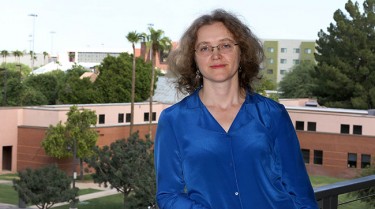By Janie Magruder
GCU News Bureau
A faculty member at Grand Canyon University spent the summer at a prestigious European science institute studying a type of bacteria that someday could produce inexpensive biofuel that does not harm the environment.
Plainly said, the tiny photosynthetic organisms could supplement oil, natural gas, coal and nuclear power and solve the world’s expensive, dirty energy problem.
Dr. Galyna Kufryk, a professor of biological sciences in GCU’s College of Science, Engineering and Technology (CSET), was invited as a visiting scientist to the Institut Pasteur in Paris. Founded by Louis Pasteur in 1887, the institute is the world’s oldest research organization in microbiology and virology, and home to the most impressive list of discoveries in those fields. It also has produced 10 Nobel Prize recipients in physiology or medicine.
Additionally, the institute houses several large collections of microorganisms, including cyanobacteria, a photosynthetic group in which Kufryk is interested.
Cyanobacteria were among are the oldest known fossils, about 3.5 billion years old. They capture sunlight and use its energy to produce organic material from carbon dioxide and water. In the process of doing so, they release oxygen that is used by many organisms, including humans. And, they are capable of producing biofuels, such as biodiesel and biohydrogen.
The potential of cyanobacteria
Kufryk and others are studying the transformation of light energy in cyanobacterial cells and how that energy ultimately can be used to produce biofuels. Specifically, she is exploring the potential of different strains of cyanobacteria for hydrogen production. As photosynthetic microorganisms, cyanobacteria can be grown inexpensively, which is a substantial advantage in making biohydrogen.
“I am working on the production of molecular hydrogen, which is the cleanest fuel possible, because when you use it, the only thing produced is water,” she said. “Gas, ethanol natural gas and diesel contain carbon and emit carbon dioxide during combustion, which creates the greenhouse effect.”
In addition to her research, Kufryk was invited to present a seminar at the Institut Pasteur. She spoke about the photosynthetic complexes of cyanobacterial and how they can be used in biohybrid systems that utilize sunlight for the production of molecular hydrogen.
“Hydrogen is our best option for an environmentally friendly and renewable biofuel, as it can be generated by living organisms such as cyanobacteria,” said Kufryk, who is teaching microbiology and genetics courses this semester. “The ultimate source of energy for hydrogen production is sunlight that is captured in the process of photosynthesis.”
From early interest in chemistry to distinguished science career
Born and raised in Ukraine, Kufryk became interested in biology at age 9 when she accidentally walked into a chemistry lab and witnessed a reaction that turned two colorless liquids into a colored one.
“I was captivated by that transformation,” she said. “I could not help but ask why it happened.”
Years later, she earned a Ph.D. in biology from the Ukrainian National Academy of Sciences and did post-doctoral work at Arizona State University, where she also taught.
It’s no coincidence that GCU rewarded Kufryk last year with the Distinguished Faculty Scholar Award from CSET. In about 20 years of scientific research and teaching, she has published in reputable journals and books in her field, spoken at a dozen global conferences and presented at nearly 30 international meetings.
“The results of her pioneering work are frequently cited by colleagues publishing in high-impact science journals such as the Proceedings of the National Academy of Sciences of the United States of America,” said Dr. Dmitrii Vavilin, a senior scientist at DuPont Industrial Biosciences in Palo Alto, Calif., who worked with Kufryk at ASU. “She is clearly an outstanding science professional, lecturer and mentor.”
Kufryk also is a co-inventor of a biohybrid system for hydrogen production that has the potential to solve the world’s energy crisis, said Dr. Brian Sillanpaa, an assistant professor of human anatomy, physiology and pathophysiology at GCU. She is a caring, compassionate educator and willing colleague and collaborator, and she is a constant participant in University events, from Move-In to Health Sciences, Technology and Engineering Day.
“Additionally, Galyna has repeatedly taken time out of her busy schedule to help our pre-med students prepare for medical school interviews,” Sillanpaa said. “I know she truly cares about student success.”

More broadly, Kufryk has been involved in numerous collaborative projects across the U.S. and Europe and is a leading author of many publications in internationally recognized science journals.
Dr. Georg Schmetterer, an associate professor of biochemistry who retired from the University of Vienna in Austria last year, worked with Kufryk to improve the efficiency of genetic transformation in cyanobacteria. Their findings were published in the FEMS (Federation of European Microbiological Societies) Microbiology Letters in 2002.
“I consider her recent work on hydrogen production using cyanobacteria or cyanobacterial proteins to be very interesting with a real prospect for future practical and even commercial applications,” Schmetterer said.
Kufryk said her Pasteur experience was like none other. “It presented a unique opportunity to work with researchers in my field and interact with scientists in other areas in microbiology, all in one place.”
Kufryk plans to return to the Institut Pasteur next summer to continue her work. She would not offer a prediction on whether and when hydrogen-fueled vehicles will be tooling down roads in Phoenix and everywhere else, putting money in our pockets and cleaner air in our lungs. However, she said, “Science has made previously unheard-of things possible.”
Contact Janie Magruder at (602) 639-8018 or [email protected].


















